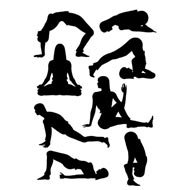- Sun Salutation
- Headstand
- Inverted Triangle Pose
- Hand to Foot Pose
- Lion Pose
- Head to One Knee Pose
- Head to Knees Pose
- Camel Pose
- Sage Marichi Twist Pose
- Half Lord of the Fish Pose
- Inverted Leg Stretch Pose
- Shoulder Stand
- Plough Pose
- Inclined Plane
- Boat Pose
- Fish Pose
- Wheel Pose
- Bridge Pose
- Downward Facing Dog Pose
- Cobra Pose
- Bow Pose
- Locust Pose
- Eagle Pose
- Peacock Pose
- Crow Pose
- Corpse Pose
- Yoga Balance Asanas
- Yoga Asanas For Spine
- Yoga Asanas in Chair
- Basic Yoga Asanas For Stomach
- Yoga Asanas For The Neck
- Yoga Asanas For Depressed
- Yoga Asanas For Beginners
- Sequencing Yoga Asanas
- One Legged King Pigeon Pose - Eka Pada Rajakapotasana
- Reclining Bound Angle Pose - Supta Baddha Konasana
- Eight Angle Pose - Astavakrasana
- Hand Clenching
- Side Crane Pose - Parsva Bakasana
- Ankle Rotation
- Circle pose - Mandalasana
- Dolphin Plank Pose
- Half Frog Pose - Ardha Bhekasana
- Four-Limbed Staff Pose - Chaturanga Dandasana
- Extended Puppy Pose - Uttana Shishosana
- Supported Headstand - Salamba Sirsasana
- Pendant Pose - Lolasana
- Shoulder-Pressing Pose - Bhujapidasana
- Ankle Bending
- Wrist Bending
- Standing Half Forward Bend
- Side-Reclining Leg Lift
- Standing Yoga Seal
- Upward Salute
- Intense Side Stretch Pose
- Wild Thing
- Great Hand Posture
- Upward Bow
- Warrior Seal
- Spread Leg Forward Fold
- Legs-Up-the-Wall Pose
- King Pigeon Pose
- Arm Pressing Posture
- Upward-Facing Dog
- Crocodile Pose
- Feathered Peacock Pose
- Reclining Angle Pose
- Reclining Hero Pose
- Half Headstand Pose
Shiva Twist - Parivrtta Natarajasana
The Shiva Twist pose is also known as the parivrtta natarajasana.
This is because in Hindu mythology Lord Shiva was known as the Lord of dance.
Shiva Twist Steps:
- To begin with the Shiva twist pose in yoga , you should first stand in the Mountain pose or the Tadasana. Thereafter inhale and shift all of your weight onto your right foot and while doing so lift your left heel towards the left buttocks while bending your knees.
- Thereafter you should press the head of your right thigh bone deep into the hip joint and try to pull the knee cap upwards to ensure that the leg that you’re standing on is as straight and strong as possible.
- Once done, you should slowly lift your left foot up, away from your torso and the floor. Thereafter try to extend your left thigh behind you and keep it as parallel to the floor as possible. Once this pose has been achieved, stretch your right arm forward parallel to the floor and in front of the torso.
- This position should be maintained for at least 30 seconds after which you should release the grasp on your foot and then place the left foot back onto the floor. This should be repeated for the similar length of time on your other side as well.
Shiva Twist - Precautions :
Those suffering from low blood pressure should not try to practice the Shiva twist as they may feel lightheaded and dizzy.
Benefits To Body Parts and Therapeutic Applications :
- The shiva twist is known to benefit almost all parts of the body of the individual focussing mostly on the knees, ankles, thighs groins, thighs, shoulders, chest, lungs, spine and kidneys.
- Another one of the benefits of the Shiva pose is that it helps in stretching the groin, abdomen, thighs, shoulders and chest.
- The Shiva twist pose is also important for strengthening of the ankles and the legs.
- This yoga pose is also beneficial in improving your overall balance.
Beginner’s Tip :
A beginner’s tip for the Shiva twist is to ensure that while lifting your leg, your ankle of the raised foot has been flexed else you may end up with a cramp in the back of your thigh.
Variations :
One of the variations of the Shiva twist is to try to balance the free hand against some wall to try and ensure that you stay stable and retain your balance.
Preparatory Poses :
- Cow Face Pose (Gomukhasana)
- Supta Virasana
- Hero Pose (Virasana)
- Hanumanasana
- Adho Mukha Vrksasana
Follow Up Poses :
Typically the Shiva twist pose is performed as a final or concluding pose of a series of various highly challenging backbends. After practicing the Shiva twist pose, it is advisable to try and release or relax the spine by entering into the half Uttanasana pose or the Right angle pose or even the reclining twist.
The intensity of the Shiva twist pose may be further deepened by holding onto your raised foot with the hand on the opposite side. Once the pose has been completed, you should then inhale deeply and try to swing your free hand towards the ceiling first and then by bending it at the elbow try and reach for the inside of the foot that is raised. Before practicing any pose of yoga irrespective of the intensity of the pose , it is always advisable to consult with your doctor , especially if your already suffering from a medical condition such as low or high blood pressure.
 Find Pose
Find Pose

